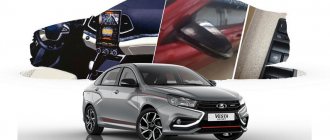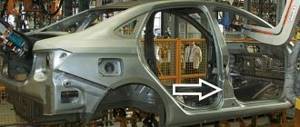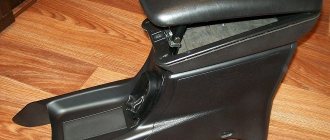Body galvanization
Body of Lada Vesta
Anti-corrosion treatment of the machine
Vesta is rightly perceived as a breath of fresh air from AvtoVAZ. They released a car with a modern design and interior, high-quality assembly and decent equipment. These are obvious improvements, but not everyone remembers whether the body of the Lada Vesta is galvanized or not. And it should, because it depends on how soon rust begins to appear on the car.
Why is galvanization needed and what is it?
Paintwork is not enough to protect the body. The slightest damage and moisture does its job, causing oxidation of the steel. The corrosion center, unnoticeable at first, grows, and the car has to be repaired.
One of the most effective ways to prevent rust formation is galvanizing the body. Auto industry leaders have been practicing this procedure for many years. Thanks to this, they can provide a warranty on the body for up to 20 years.
The body can be galvanized in the following ways:
- heat treatment;
- galvanic treatment;
- cold processing.
During thermal galvanizing, the car body is completely immersed in a special zinc-containing solution and heated to a certain temperature. This method is the most effective and is used on expensive cars.
Galvanizing the body The galvanic method involves the application of zinc particles during the electrolysis process. The body or part is placed in an acidic zinc solution and exposed to electric current. This method is not as reliable, but is cheaper.
Interesting!
The duration of the warranty directly depends on the galvanizing method and the thickness of the resulting layer.
With the cold method, the body is simply treated with a zinc-containing primer. In this case, manufacturers do not provide a long-term guarantee, because the protective layer may be damaged along with the paint.
About the reliability of paintwork messages
As the developers stated, the quality of the coating turned out to be at a decent level. You are unlikely to find any defects or imperfections on the painted body surface. Here, the small thickness of the paint layer can generate certain doubts.
The trend of reducing the thickness of the coating for the sake of the environment is quite popular in the world.
But the Lada Vesta has a reliable primer coating that can protect against corrosion even in places where the paint has chipped, but does the body rot? The bottom, sills and arches are treated with an additional layer of anti-gravel coating.
If suddenly your LADA Vesta begins to rust during the warranty period, immediately contact the dealership, since you have the right to demand reimbursement of repair costs, the body warranty allows you to do this.
Expectations from Lada Vesta
Domestic cars had an eternal problem in the form of weak paintwork and the rapid formation of corrosion. Remember the same Priora, which within a year could acquire rusty areas, which is simply unacceptable for a modern car.
With the first announcements, it became clear that the Lada Vesta will be a car of a new level. Car owners shared their assumptions about what kind of body the Lada Vesta has and that it will finally have normal corrosion protection. Representatives of the plant assured the public that in this regard their new product would not disappoint anyone and even promised to provide a guarantee on the body.
Coverage scheme
Despite the presence of galvanized bodywork on the Lada Vesta and X-Ray, this is not the only protection. Stanislav demonstrated a section of a body element drawn on the board. It includes the following components:
- Steel – thickness from 0.6 to 0.8 mm;
- Zinc;
- Primary cataphoretic primer;
- Recycled polyester primer;
- Enamel;
- Varnish.
This applies to external components. If we consider the internal panels, for example, the bottom, then between the layers of cataphoretic and polyester primer a mastic with anti-noise properties is applied, or a special mastic if it is a weld.
What kind of body did the Lada Vesta end up with?
Body of the Lada Vesta AvtoVAZ really kept its promise and improved the quality of the body, and even gives a six-year warranty on it instead of the originally promised five-year.
This is still not much when compared with market leaders, but still better than nothing. Galvanized or not? Yes, galvanization is present. True, the cold method is not the most reliable - the body is processed only from the outside, with the exception of the floor screen, which is protected on both sides. The peculiarity is that not liquid, but powdered zinc is used - this way all the cracks and bends will be filled more efficiently.
The thickness of the zinc layer does not exceed 8 microns - this became the determining factor in calculating the warranty period.
Interesting!
Vesta is the first car in the Lada line, the surface of which is completely (except for the roof) covered with a layer of zinc.
In terms of corrosion protection, the main focus is on cataphoretic priming, one of the tasks of which is to protect the zinc layer. The process involves immersing the body in a cataphoresis bath. The anode is connected to the body, and the cathode is connected to the bath. Thus, positively charged soil will settle on the negatively charged metal, and the body will be completely covered with a film that has sufficient rigidity for full protection.
Interesting!
Cataphoretic priming is similar in principle to galvanic galvanizing, only instead of zinc particles, soil settles on the body.
How long will it last?
Along with the question of whether the body of the Lada Vesta is galvanized or not, many are interested in the validity period of this protection. The manufacturer itself provides a six-year warranty. Before launching into mass production, such a body was tested in a salt fog box. The body was in this room for about two and a half months. As the result showed, the body of the Lada Vesta coped well with the test. But how long will the metal last after the warranty period? Experts present their calculations. If one hundred microns of zinc is enough for 80-100 years, then a factory layer of 8-10 microns will last about seven to ten years. What to do after this period has expired? It is necessary to regularly monitor the condition of the paintwork and take preventive measures. We will talk about them further.
Knowing whether the body of the Lada Vesta is galvanized or not, you should not neglect preventive measures. First of all, this concerns washing. It should be regular, especially in winter. Many will say, why spend money and wash off dirt if it will protect the paint in an even layer from the same deposit. This belief is completely wrong. The fact is that in winter this dirt contains reagents that are sprinkled on the road by public utilities. And the larger the layer, the higher the risk of corrosion. This is especially true for areas that are treated only with a primer, without zinc. When washing, we pay special attention to arches and other hidden cavities (sills, bottom of wings). These places begin to rot first. Periodically check the drainage holes (at the bottom of thresholds and doors). They shouldn't be clogged. Otherwise, this will significantly accelerate the corrosion processes.
You can also protect the body from sandblasting by gluing a transparent protective film. It will not only prevent corrosion, but will preserve the color and integrity of the body in its original form.
Is Lada Vesta's paintwork reliable?
Anti-corrosion treatment of the machine The quality of the paint and varnish coating is also at the highest level.
Amateurs and automobile experts checked whether the Lada Vesta's paintwork was reliable. No imperfections, scuffs or various coating defects, which often happened on previous models, were noticed. Although the small thickness of the Lada Vesta LPC may raise doubts. But this trend is characteristic of many modern cars - environmental standards impose restrictions on the depth of the paint and varnish layer. High-quality soil protects the iron well, and corrosion is unlikely to spread due to ordinary chips.
The bottom, sills and arches have been additionally treated with a layer of anti-gravel. In total, the thickness of the body metal is about 0.7 mm.
On a note!
If a Lada Vesta with a galvanized body rusts during the warranty period, do not hesitate to contact the dealer. You have the right to demand reimbursement of the cost of repair or elimination of this problem.
Do they process only Vesta?
Many will now ask why the manufacturer began to think about this issue only with the release of Vesta. This is not entirely true. The fact is that other VAZ models were also galvanized. These are Priora (models after 2009), second generation Kalina and Lada Granta. But as before, the body was not completely processed. Thus, on the Kalina there was no galvanization on the rear and front side members, the roof and the hood. To eliminate corrosion at least partially, it was necessary to install wheel arch liners. The Priora was treated almost everywhere, with the exception of the roof and hood. But again, you can’t do without lockers here.
"Vesta" is treated with zinc over the entire outer surface (including the rear fenders), except for the roof. Additionally, some areas are treated with anti-gravel. These are the sills, the bottom and the arches.
Yes, AvtoVAZ has previously used cold galvanizing technology. But it is best implemented on Vesta.
Is additional anti-corrosion treatment required for the Lada Vesta body?
Vesta's corrosion protection is at an acceptable level. All areas considered to be at risk have been thoroughly processed. In this regard, the plant did a good job, and you can make additional anticorrosive at your discretion.
But it is worth remembering that the service life of the body depends not only on the quality of galvanization and paintwork, but also on the owner’s attitude towards his car. If you neglect regular washing and do not get rid of paintwork damage in a timely manner, the car may soon rust and in this case additional anti-corrosion treatment is necessary.
Galvanizing and painting the Lada Vesta body
Many people spoke with aspiration about the new Lada Vesta sedan at AvtoVAZ.
And why should we be surprised? After all, Bu Inge Andersson, who was appointed director of the Russian automobile giant in those glorious and difficult times, firmly stated that he would certainly improve the quality of the company’s products.
And, as the course of events has shown, he has achieved considerable success in this direction. Design, interior design, build quality of the new sedan - all this has increased by an order of magnitude. And the contrast with other models of the Togliatti plant only confirmed that he was right.
Among other things, the aspect of galvanizing and painting the body remained extremely important. Will Vesta be able to resist corrosion better than other representatives of the VAZ family? Is the 5-year warranty provided by the factory a reality or a marketing ploy? Has the thickness of the paintwork increased? All this needs to be clarified.
New Lada: Repair manual for Lada Kalina (VAZ-11183)
Quality checking
Thickness
It is precisely checking the thickness of the paintwork on Lada Vesta and X-Ray that is perhaps the most important aspect, because many buyers pay attention to the thickness of the coating. Therefore, at AvtoVAZ, inspection of this indicator is carried out daily on all parts. For this, a special tool is used - a thickness gauge.
The coating itself consists of 2 layers of primer, a layer of paint and a layer of varnish. At the same time, the permissible difference in the thickness of the paintwork on the Lada Vesta and X-Ray is only 40 microns.
Brightness and shine
In addition to thickness, the brightness of the paint is also tested, for which powerful lighting is installed in the workshop. Testing is carried out with special devices that are applied to the part and show the brightness of the paint in units of change. The gloss level of the body is also subject to measurement.
This is extremely important, especially in areas where metal components meet plastic components (bumpers, etc.).
Shagreen
To measure the shagreen color of the varnish that forms after painting the Lada Vesta and X-Ray is completed, a small special device is also used. During the production process, the plant is required to maintain a “reproducibility index” of 85-90 units.











